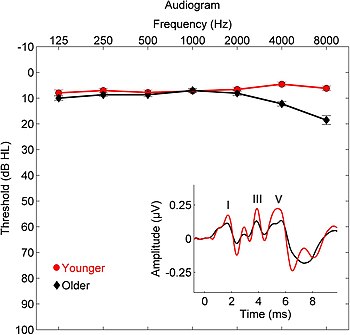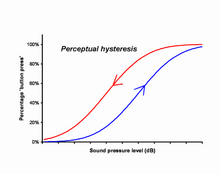
Pitch is a perceptual property of sounds that allows their ordering on a frequency-related scale, or more commonly, pitch is the quality that makes it possible to judge sounds as "higher" and "lower" in the sense associated with musical melodies. Pitch is a major auditory attribute of musical tones, along with duration, loudness, and timbre.

The phon is a logarithmic unit of loudness level for tones and complex sounds. Loudness is measured in sones, a linear unit. Human sensitivity to sound is variable across different frequencies; therefore, although two different tones may present an identical sound pressure to a human ear, they may be psychoacoustically perceived as differing in loudness. The purpose of the phon is to provide a logarithmic measurement for perceived sound magnitude, while the primary loudness standard methods result in a linear representation. A sound with a loudness of 1 sone is judged equally loud as a 1 kHz tone with a sound pressure level of 40 decibels above 20 micropascal. The phon is psychophysically matched to a reference frequency of 1 kHz. In other words, the phon matches the sound pressure level (SPL) in decibels of a similarly perceived 1 kHz pure tone. For instance, if a sound is perceived to be equal in intensity to a 1 kHz tone with an SPL of 50 dB, then it has a loudness of 50 phons, regardless of its physical properties. The phon was proposed in DIN 45631 and ISO 532 B by Stanley Smith Stevens.

Psychophysics quantitatively investigates the relationship between physical stimuli and the sensations and perceptions they produce. Psychophysics has been described as "the scientific study of the relation between stimulus and sensation" or, more completely, as "the analysis of perceptual processes by studying the effect on a subject's experience or behaviour of systematically varying the properties of a stimulus along one or more physical dimensions".

In acoustics, loudness is the subjective perception of sound pressure. More formally, it is defined as the "attribute of auditory sensation in terms of which sounds can be ordered on a scale extending from quiet to loud". The relation of physical attributes of sound to perceived loudness consists of physical, physiological and psychological components. The study of apparent loudness is included in the topic of psychoacoustics and employs methods of psychophysics.
In the branch of experimental psychology focused on sense, sensation, and perception, which is called psychophysics, a just-noticeable difference or JND is the amount something must be changed in order for a difference to be noticeable, detectable at least half the time. This limen is also known as the difference limen, difference threshold, or least perceptible difference.

The acoustic reflex is an involuntary muscle contraction that occurs in the middle ear in response to loud sound stimuli or when the person starts to vocalize.
An otoacoustic emission (OAE) is a sound that is generated from within the inner ear. Having been predicted by Austrian astrophysicist Thomas Gold in 1948, its existence was first demonstrated experimentally by British physicist David Kemp in 1978, and otoacoustic emissions have since been shown to arise through a number of different cellular and mechanical causes within the inner ear. Studies have shown that OAEs disappear after the inner ear has been damaged, so OAEs are often used in the laboratory and the clinic as a measure of inner ear health.

Audiometry is a branch of audiology and the science of measuring hearing acuity for variations in sound intensity and pitch and for tonal purity, involving thresholds and differing frequencies. Typically, audiometric tests determine a subject's hearing levels with the help of an audiometer, but may also measure ability to discriminate between different sound intensities, recognize pitch, or distinguish speech from background noise. Acoustic reflex and otoacoustic emissions may also be measured. Results of audiometric tests are used to diagnose hearing loss or diseases of the ear, and often make use of an audiogram.
In neuroscience and psychophysics, an absolute threshold was originally defined as the lowest level of a stimulus – light, sound, touch, etc. – that an organism could detect. Under the influence of signal detection theory, absolute threshold has been redefined as the level at which a stimulus will be detected a specified percentage of the time. The absolute threshold can be influenced by several different factors, such as the subject's motivations and expectations, cognitive processes, and whether the subject is adapted to the stimulus.
The absolute threshold can be compared to the difference threshold, which is the measure of how different two stimuli must be for the subject to notice that they are not the same.
In audiology and psychoacoustics the concept of critical bands, introduced by Harvey Fletcher in 1933 and refined in 1940, describes the frequency bandwidth of the "auditory filter" created by the cochlea, the sense organ of hearing within the inner ear. Roughly, the critical band is the band of audio frequencies within which a second tone will interfere with the perception of the first tone by auditory masking.

An audiogram is a graph that shows the audible threshold for standardized frequencies as measured by an audiometer. The Y axis represents intensity measured in decibels (dB) and the X axis represents frequency measured in hertz (Hz). The threshold of hearing is plotted relative to a standardised curve that represents 'normal' hearing, in dB(HL). They are not the same as equal-loudness contours, which are a set of curves representing equal loudness at different levels, as well as at the threshold of hearing, in absolute terms measured in dB SPL.
In psychophysics, sensory threshold is the weakest stimulus that an organism can sense. Unless otherwise indicated, it is usually defined as the weakest stimulus that can be detected half the time, for example, as indicated by a point on a probability curve. Methods have been developed to measure thresholds in any of the senses.

Hearing range describes the range of frequencies that can be heard by humans or other animals, though it can also refer to the range of levels. The human range is commonly given as 20 to 20,000 Hz, although there is considerable variation between individuals, especially at high frequencies, and a gradual loss of sensitivity to higher frequencies with age is considered normal. Sensitivity also varies with frequency, as shown by equal-loudness contours. Routine investigation for hearing loss usually involves an audiogram which shows threshold levels relative to a normal.

Pure-tone audiometry is the main hearing test used to identify hearing threshold levels of an individual, enabling determination of the degree, type and configuration of a hearing loss and thus providing a basis for diagnosis and management. Pure-tone audiometry is a subjective, behavioural measurement of a hearing threshold, as it relies on patient responses to pure tone stimuli. Therefore, pure-tone audiometry is only used on adults and children old enough to cooperate with the test procedure. As with most clinical tests, standardized calibration of the test environment, the equipment and the stimuli is needed before testing proceeds. Pure-tone audiometry only measures audibility thresholds, rather than other aspects of hearing such as sound localization and speech recognition. However, there are benefits to using pure-tone audiometry over other forms of hearing test, such as click auditory brainstem response (ABR). Pure-tone audiometry provides ear specific thresholds, and uses frequency specific pure tones to give place specific responses, so that the configuration of a hearing loss can be identified. As pure-tone audiometry uses both air and bone conduction audiometry, the type of loss can also be identified via the air-bone gap. Although pure-tone audiometry has many clinical benefits, it is not perfect at identifying all losses, such as ‘dead regions’ of the cochlea and neuropathies such as auditory processing disorder (APD). This raises the question of whether or not audiograms accurately predict someone's perceived degree of disability.
In audio signal processing, auditory masking occurs when the perception of one sound is affected by the presence of another sound.
The hypersonic effect is a phenomenon reported in a controversial scientific study by Tsutomu Oohashi et al., which claims that, although humans cannot consciously hear ultrasound, the presence or absence of those frequencies has a measurable effect on their physiological and psychological reactions.
Dichotic pitch is a pitch heard due to binaural processing, when the brain combines two noises presented simultaneously to the ears. In other words, it cannot be heard when the sound stimulus is presented monaurally but, when it is presented binaurally a sensation of a pitch can be heard. The binaural stimulus is presented to both ears through headphones simultaneously, and is the same in several respects except for a narrow frequency band that is manipulated. The most common variation is the Huggins Pitch, which presents white-noise that only differ in the interaural phase relation over a narrow range of frequencies. For humans, this phenomenon is restricted to fundamental frequencies lower than 330 Hz and extremely low sound pressure levels. Experts investigate the effects of the dichotic pitch on the brain. For instance, there are studies that suggested it evokes activation at the lateral end of Heschl's gyrus.
Minimum audibility curve is a standardized graph of the threshold of hearing frequency for an average human, and is used as the reference level when measuring hearing loss with an audiometer as shown on an audiogram.
Psychoacoustics is the branch of psychophysics involving the scientific study of sound perception and audiology—how human auditory system perceives various sounds. More specifically, it is the branch of science studying the psychological responses associated with sound. Psychoacoustics is an interdisciplinary field of many areas, including psychology, acoustics, electronic engineering, physics, biology, physiology, and computer science.
Infrasound is sound at frequencies lower than the low frequency end of human hearing threshold at 20 Hz. It is known, however, that humans can perceive sounds below this frequency at very high pressure levels. Infrasound can come from many natural as well as man-made sources, including weather patterns, topographic features, ocean wave activity, thunderstorms, geomagnetic storms, earthquakes, jet streams, mountain ranges, and rocket launchings. Infrasounds are also present in the vocalizations of some animals. Low frequency sounds can travel for long distances with very little attenuation and can be detected hundreds of miles away from their sources.

















